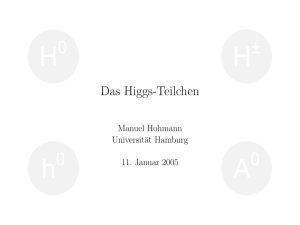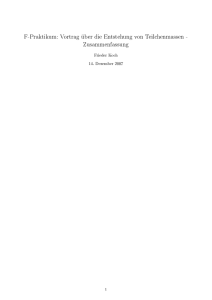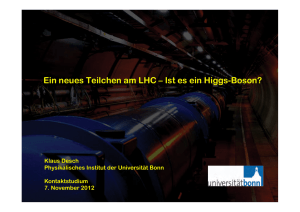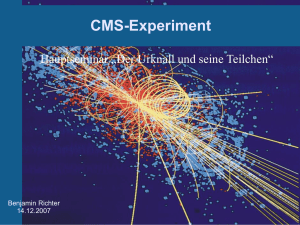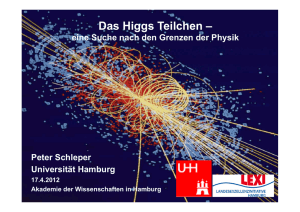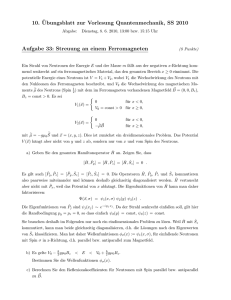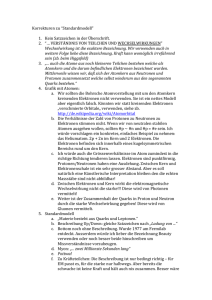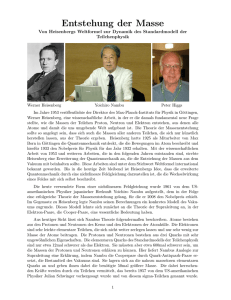what is the origin of mass? woher kommt die masse?
Werbung
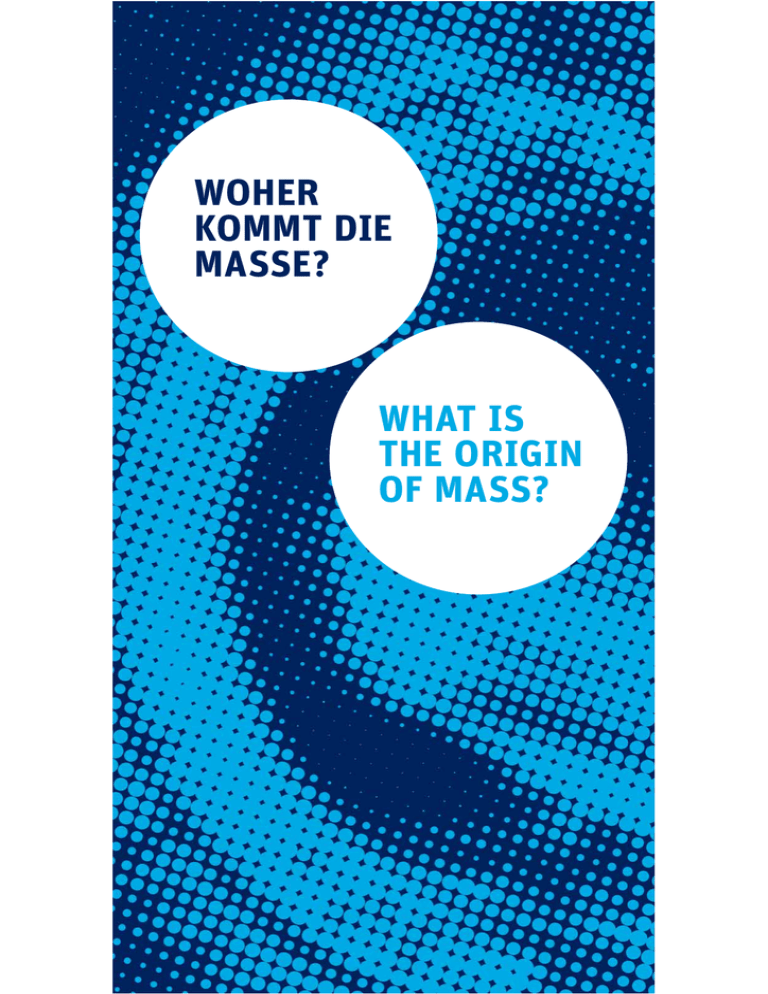
WOHER KOMMT DIE MASSE? WHAT IS THE ORIGIN OF MASS? Higgs – die Krone des Standardmodells Higgs – the crown of the Standard Model Wissenschaftler wissen bisher nicht, über welchen Mechanismus die Elementarteilchen, aus denen Materie besteht, ihre Masse erhalten. Als Verursacher haben sie das Higgs-Feld in Verdacht, das überall im Universum vorhanden sein soll. Scientists still do not fully understand what mechanism gives mass to the elementary particles that make up matter. They suspect it has something to do with the so-called Higgs field, which is thought to be present throughout the universe. Laut Peter Higgs, einem britischen Physiker, besteht das Universum aus einer Art „Quantensirup“, dem Higgs-Feld. Dieser Quantensirup bremst die durch ihn fliegenden Teilchen, er zieht praktisch an ihnen. Dadurch gewinnen sie an Masse. Je stärker ein Teilchen auf das Higgs-Feld reagiert, umso mehr Masse hat es, und umso leichter kann es wiederum das Higgs-Feld in Schwingungen versetzen. Diese Schwingungen erzeugen die Higgs-Teilchen, nach denen man seit mehr als 40 Jahren sucht und die nun mit dem LHC nachgewiesen werden sollen. According to the British physicist Peter Higgs, the universe is composed of a kind of “quantum fluid”, known as the Higgs field. This quantum fluid slows down particles as they fly through it, causing them to acquire mass. The more a particle reacts to the Higgs field, the greater its mass, and the more it can make the field oscillate. It is these oscillations that generate the Higgs particles. Hopefully, the Higgs particles can now be definitively identified at the LHC, thus ending a search that has lasted over 40 years. Doch selbst wenn das Higgs-Teilchen nicht gefunden wird, muss es einen alternativen Mechanismus zur Erzeugung der Massen geben. Der LHC wird daher auf jeden Fall neue Entdeckungen ermöglichen. On the other hand, should it prove impossible to detect a Higgs particle, there must be an alternative mechanism that gives particles their mass. In other words, the LHC will enable new scientific discoveries, whether it finds the Higgs particle or not. Eine Party! Es wimmelt von Menschen. Ein Star tritt durch die Tür, die Partybesucher stürzen sich auf ihn. Er schafft es nur mit Mühe, den Raum zu durchqueren. Die Partybesucher stehen für das Higgs-Feld des Standardmodells. Der Star wird langsamer, als erhielte er aufgrund seiner Wechselwirkung mit dem Higgs-Feld eine Masse. A party crowd has gathered. Suddenly, a film star enters the room. He is immediately surrounded by a flock of admirers who hamper his progress through the room. The crowd of partygoers are like the Higgs field as postulated in the Standard Model. The star’s movement slows down, just as though his interaction with the Higgs field – the crowd – had given him a mass. Was wäre, wenn … What if … … das up-Quark eine größere Masse als das down-Quark hätte? Up- und down-Quarks sind die Hauptbestandteile unserer Materie. Sie bilden die Protonen und Neutronen, aus denen die Atomkerne aufgebaut sind. Protonen bestehen aus zwei upund einem down-, Neutronen aus zwei downund einem up-Quark. Das up-Quark ist etwas leichter als das down-Quark. Wäre es genau umgekehrt und die Masse des up-Quarks größer als die des down-Quarks, wäre das Proton etwas schwerer als das Neutron. Protonen würden sich nach kurzer Zeit in Neutronen umwandeln, freie Neutronen dagegen könnten für immer existieren. Wenige Stunden nach dem Urknall wären nur Neutronen, Neutrinos und Photonen in unserem Universum übrig geblieben. Es hätten sich weder Wasserstoff noch andere chemische Elemente gebildet, und statt leuchtender Sterne wären dunkle Neutronenklumpen entstanden. … the up quark had a larger mass than the down quark? Up and down quarks are the main constituents of matter as we know it. They form protons and neutrons, which in turn make up atomic nuclei. Protons consist of two up and one down quark, neutrons of two down and one up quark. The up quark is slightly lighter than the down quark. If the up quark had a larger mass than the down quark, the proton would be slightly heavier than the neutron. This would mean that protons would transform rapidly into neutrons, free neutrons, by contrast, would exist forever. Only neutrons, neutrinos and photons would have remained within a few hours of the Big Bang. Neither hydrogen, nor other chemical elements would have developed, and instead of shining stars dark lumps of neutrons would have formed.
